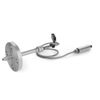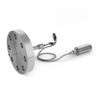Energía térmica
Discover how to check the pressure in your thermal energy storage system
High temperature pressure transducer for thermal energy storage systems
The pressure transducers designed for high temperatures are essential for monitoring the pressure in the heat convection fluids used in storage systems. With their resistance and precision, they guarantee reliable measurements even in the presence of high-temperature viscous fluids.
The process
Thermal storage technologies can be used to store thermal energy for long periods, allowing greater penetration of intermittent renewable sources (such as solar and wind), as well as favouring flexible generation from conventional sources to cover seasonal demand.
Storage solutions fall into three main categories:
- Sensible heat storage – storage of heat in materials such as molten salts, rocks, sand or cement;
- Latent storage – use of heat associated with phase changes of materials (e.g. melting);
- Thermochemical energy storage – exploitation of reversible chemical reactions to store energy.
A simple example of thermal storage is the classic water tank, which is heated during peak energy hours and then used as a heat source when energy is less available. These technologies can also be used to balance energy consumption between day and night.
Technology
Thermal energy storage is one of the most effective strategies for managing energy over time. It consists in:
- Postponing the use of thermal energy (or electricity converted into heat), to a time later than when it was generated;
- Converting energy into a storable form;
- Storing energy and then converting it back into electricity or thermal energy when necessary.
The benefits of the product
To measure pressure in high-temperature heat-transfer fluids, it is necessary to use sensors designed for extreme conditions.
The Gefran pressure transmitters of the CSP family are designed to meet the stringent application requirements of these systems. The main and most important feature of these sensors is their ability to measure the pressure of a viscous fluid at high temperature.
Their main technical characteristics include:
- Pressure measurement at temperatures up to 600°C
- Hydraulic transmission of pressure via incompressible liquid (NaK – Sodium/Potassium)
- Sensitive element that uses a Wheatstone bridge strain gauge with thick film technology
- Robust design with rigid stem and flexible sheath, which means the electronic zone can be remote
- Flange attachment, for a stable and secure connection to the process
These features make Gefran sensors ideal for complex systems and thermally challenging environments.
Thick film on steel technology
The Gefran sensors of the CSP series employ the “thick film” on steel technology, which ensures reliability and robustness over time.
Using the screen printing process, the following elements are deposited on the steel membrane:
- Insulating layers (dielectric)
- Conductive layer (cermet)
- Resistive layer for the Wheatstone Bridge
Through a heat treatment divided into several phases, which include reaching a temperature of 900°C, the different layers are consolidated with the measuring membrane, ensuring robustness, stability and accuracy in sensor readings over the long term.
The thickness of the membrane determines the measurement range, adapting to fluid pressures under complex operating conditions.
Installation
Proper installation is crucial for the reliable operation of the pressure sensor.
Practical tips:
- Do not install the sensor tip directly into the main tube: it is preferable to use a piezometric deflection branch to avoid interference with the direct flow.
- Avoid insulation of the sensor stem: thermal insulation should be limited to the area under the flange, leaving the stem uncovered to reduce unwanted heat transfer.
These precautions reduce the risk of thermal drift and help keep the sensor stable and accurate over time.


